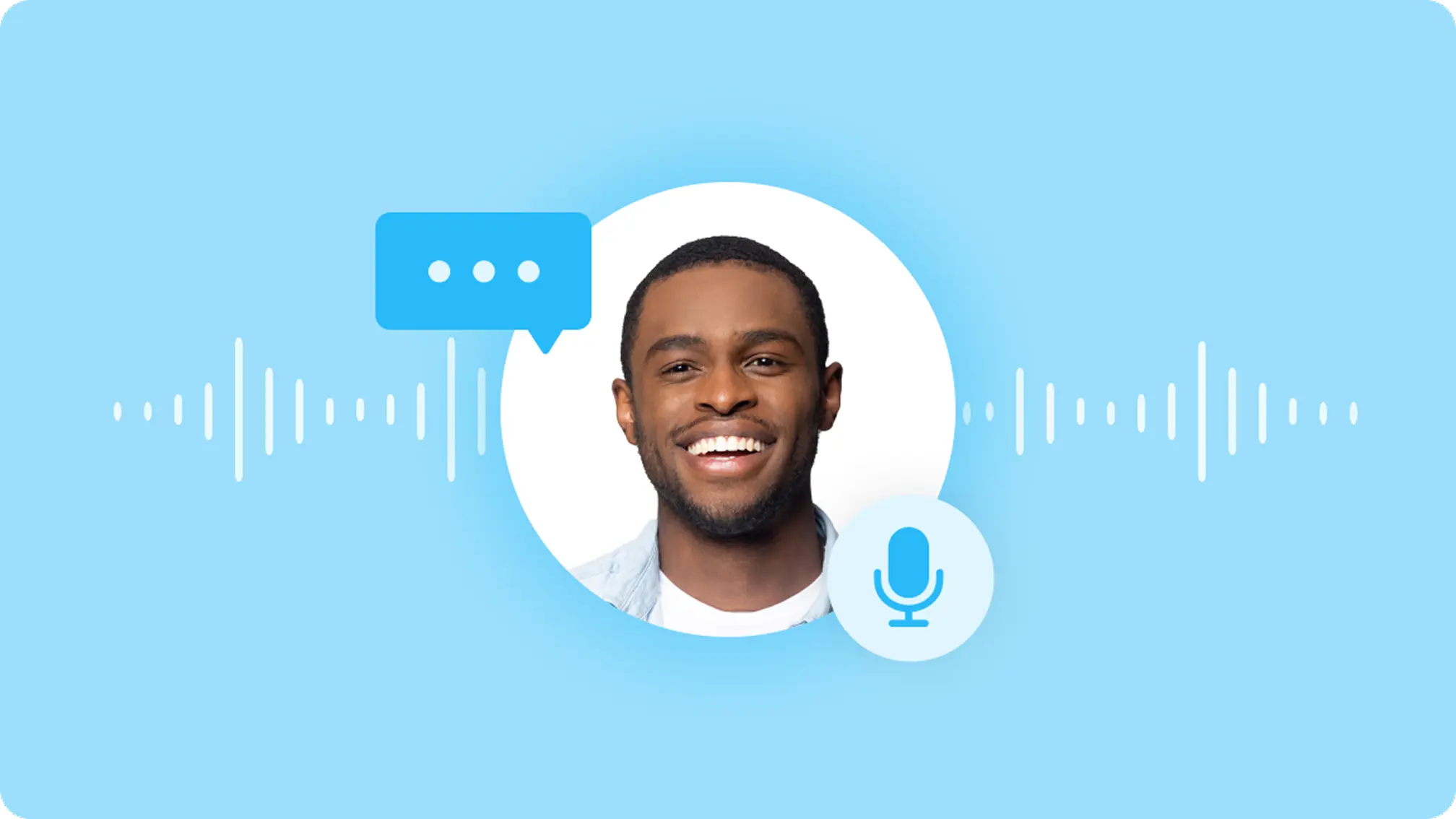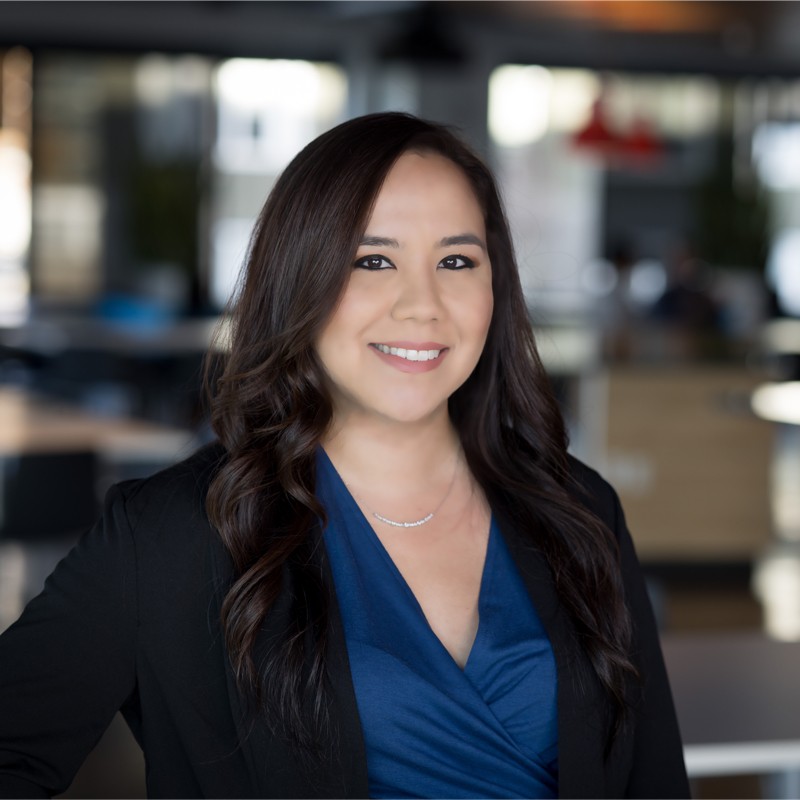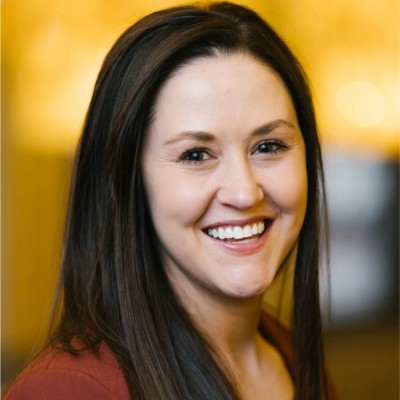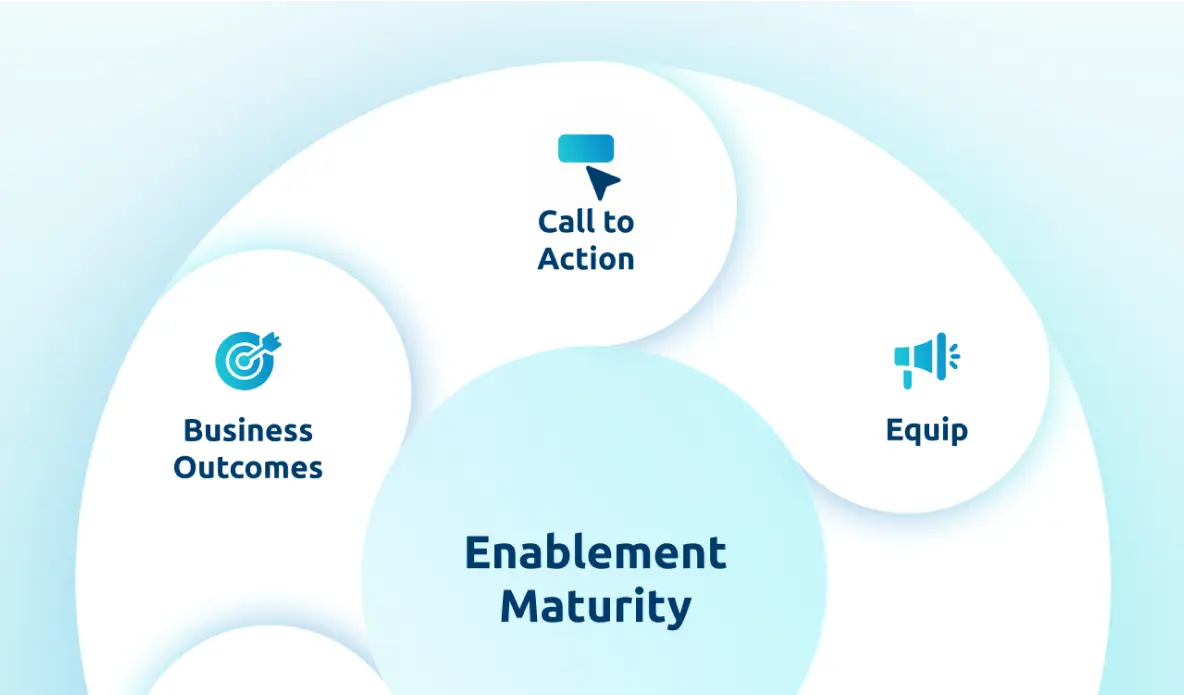Research from Sales Enablement PRO found that companies with a consolidated tech stack see a 19 percentage point higher average quota attainment than teams with multiple disconnected tools.
Shawnna Sumaoang: Hi, and welcome to the Win Win Podcast. I am your host, Shawnna Sumaoang. Join us as we dive into changing trends in the workplace and how to navigate them successfully.
How can you boost rep productivity with a unified sales enablement platform? Here to discuss this topic is Andrea Holzworth, the vice president of sales enablement and customer operations at Project Lead The Way. Thank you for joining us, Andrea. I’d love for you to tell us about yourself, your background, and your role.
Andrea Holzwarth: Thank you for having me today. I’m Andrea Holzwarth, as you mentioned serving as the vice president of sales enablement and customer operations for Project Lead The Way. I’ve been with Project Lead The Way for eight years now served in a variety of roles. Mostly on our sales team, so I served on our school success team, our new district engagement team, and our strategic accounts team. I recently transitioned over to our customer operations team in July, and really in this role I serve as the leader of our sales enablement, so providing our sales team with all the resources that they need, all the professional development coaching training they need, while also solving some of those operational challenges that we may have. Whether those are internal or external, just making it easier for our customer to implement Project Lead The Way.
SS: I love that. Now, prior to Highspot, you were leveraging a different platform for enablement, including a separate learning management system. Can you tell us about that experience and ultimately what led you to decide to really consolidate your enablement tech stack?
AH: As you mentioned, we were using a variety of resources, and as you can imagine with a variety of resources, there’s really no source of truth of where the right resource is, or where that learning is. And so, Highspot really was selected by Project Lead The Way as our sales enablement tool because of its ability to be the source of truth but also its ability to integrate into Salesforce. It’s an easy-to-build learning management system for us.
A couple of the other things that we really appreciated about Highspot was the ability to provide sales plays to our team. So, the “know, say, show, and do” to really equip our team with the right resource at the right time to the right audience. And then we also really appreciated the development of talk tracks and how we can provide team members the opportunity to listen to their peers and some of those role-play conversations around targeted topics or specific PLTW programs.
SS: I love that. What have you seen as the impact of having a unified solution rather than separate siloed tools?
AH: We’ve seen quite a bit of impact so far, but I’ll say that Highspot really provided our team a unified vocabulary and again, that single source of truth. And it also allowed our sales team to be really more efficient and effective in the field. Instead of digging around trying to find that one resource, they were able to find everything in one spot.
And it was also tagged correctly. And I say “spot” a little bit of pun intended there, but it allowed them to find everything they needed. I mentioned this earlier, but we do like to say the right resource, right time for that right audience.
SS: I love that. And you guys are actually driving fantastic adoption across the board, so kudos to you and the team. I believe you guys have a 95% pitch adoption rate and 68% play adoption. What were your best practices for ensuring a successful launch when you first rolled out Highspot?
AH: Yeah, we’re very excited and encouraged about our initial implementation, definitely some early wins for us, which has been just phenomenal for our sales enablement team, but also for our sales team as well. We took two approaches and I will say that we started developing our implementation plan far before our launch date. We wanted to really take a two specific approaches. The first approach is the “do with, not do to” mentality. And the second was to go slow to go fast later. Obviously, those sound very corny, but that’s what we kept going back to every time we were developing our implementation plan.
We wanted our team to feel those small victories along the way. So we started off with really small monthly learning. I’ll give an example: our launch date was actually October 5th, and we shared only one expectation for the month of October for our full team. Send five pitches. That seems kind of small and some people got it done within hours and the others took a couple of days or weeks. And that’s okay because that’s all they need to do is send five pitches. We wanted to bring everyone alongside us and have an impact on that early timeline.
We wanted them to get comfortable. The other piece that we did too develop a feedback group before our launch date and this has helped us to pre-identify some team members that we thought would be early adopters. And most of them are, and so that has helped us gain feedback from our, from those using it. So again, do with, not do to.
SS: I love that motto. Along those lines, as you mentioned, one of those things that you did to help build that momentum was get feedback and create a super user group. Tell us more about that. How did that help you drive adoption?
AH: Yeah, so we developed that super user group or we call it our engagement team feedback group – and just for reference our sales team at Project Lead The Way is referenced as our engagement team – we wanted them to be those that were driving the adoption So we didn’t want it to be something that was happening.
From the operations team, you must do this. It is really like I’m doing with them and we wanted them to be leaders within their groups, so we asked for a couple of commitments right away from those team members and those commitments were one: commit for a whole group, a whole year to be in that group, and not to prioritize meetings. We know that there’s lots of meetings, lots of conflicts, but to prioritize attendance.
And the second one was really laid out pretty clearly was we want to provide Brene Brown’s “clear is kind” feedback, meaning we didn’t want it to just say, “Hey, this is great.” “No, it’s all going well.” What wasn’t going well, how could we learn that? Before we took that learning to our full sales team, we can work out some of those kinks. And then the other thing that we’ve really seen success with is this group has continued to provide that feedback along the way, but they’ve also taken their learnings and experience and shared it with their home teams.
And that wasn’t a requirement and something we even said it’s just they were identified by their leaders as being super users And so it was a nice way for them to have some of that peer-to-peer learning As opposed to you know, the customer operations team coming in and sharing so we host those monthly learnings as a full team And then our super user group goes and shares in their individual teams, which they also kind of share some of their tips or tricks how to do something a little faster or a workaround which is just fun to see as well.
SS: I really love that approach. I hope some of our other customers can take advantage of that and implement that within their own organizations. Now, rolling out a new tool and driving adoption can also require some behavior change. What are some of your best practices for motivating that behavior change?
AH: We all know change is hard. No matter what change you’re going through, your personal, professional, change is going to be hard. Everyone has a certain threshold of change that they can take before it becomes uncomfortable. We really wanted to sit there and identify and bring everyone alongside us in that change, so we wanted them maybe to feel pushed a bit outside comfort zone, but never to go past that threshold. We wanted them to feel successful. I think that’s one best practice. Not going again too fast, maintaining some of that slow momentum. So you’re bringing everyone with you.
The thing that we’ve loved to see over the last couple of months, their implementation is we have some that aren’t necessarily the super users, but yet they still want more. They want to keep learning more. They want some more nuggets where we have another group who’s just kind of staying along right alongside our learning. So it’s been a really nice thing there. Another best practice I mentioned earlier, but again, it’s. Do with, not do to – so how can we bring everyone with us in this learning? How do we make everyone feel a part of our implementation? It’s not something that they have to do, it’s something they’re getting to do.
The other thing that we really did in the beginning was share the end result. Highspot was a change and our team is very mission-driven at Project Lead The Way, so we wanted to showcase to them how utilizing Highspot was going to feel better to our customers. One of PLTW’s core values is customer centricity. Our customers are at the center of all that we do. And we truly believe that Highspot as a resource makes a more customer, seamless customer experience. And so we shared that with our team and showcased that to the team so they knew that, “hey, I’m not only doing this because we’re changing over to this, but it’s also better for my customers that I’m serving.”
Lastly, I’d say data helps. So we’re now able to showcase to our teams how effective their outreach is. In some ways before, we could say if someone was opening an email, but now we can show if they’ve opened it, how long they viewed it, did they share it. And we were just somewhat in the dark before. Empowering our team with data, just helping them to want to own some of their own learning and Highspot, too.
SS: I think that’s fantastic. And you guys actually have a very unique and specialized sales team at Project Lead The Way. A lot of them actually come from a teaching background rather than a traditional sales background, which is amazing.
What are some of the unique considerations you have for driving behavior change amongst a slightly less than traditional sales team, and how does Highspot help?
AH: At Project Lead The Way, we see a strong value of team members who have that experience from our customer base within our PLTW network. Many of our team members do come from our network prior to joining us. I’m going to go back to what I mentioned earlier, but Highspot provided us with that common vocabulary. It also gave us consistency across the board, and we could share that there was something that if a school was contacting us in California or even in Florida, they were having that same customer experience because of Highspot, we were able to showcase that consistency.
It’s also provided an easy button for our account owners and they don’t have to search for things. They don’t have to maybe assume that someone needs something or, you know, try and put themselves in those, the shoes of that customer. We really have done that legwork for them by putting things in particular spots and showcasing or tying them to the correct opportunity stage. We’ve made the easy button, so there’s not a lot of other additional thinking. They can just build the relationship, which is what our accountants are so good at; building relationships with our school districts.
SS: I love that. Training programs play a really big role in being able to drive behavior change. One of your key initiatives for the year ahead is to build out robust onboarding and training programs. How are you designing these programs and leveraging Highspot to help deliver them?
AH: We believe that onboarding for a new team member is one of the most crucial times when you’re bringing on a new team member during their tenure. We want every team member to get that best fundamental start. We want them to be foundationally sound but also see the buy-in and understand where we’re going as an organization, and we believe we had a pretty strong onboarding experience before. But, a lot of our onboarding was built in-house, and it was a lot of meetings with other individuals, and we are trying to take down the amount of meetings that we may have, and we’re trying to define, but also decide what is the best way for some of that learning.
Highspot’s learning management has helped us do that because we can build courses. We can also check for understanding along the way. It’s not going to replace every meeting. We believe, again, those first four weeks are really crucial. We want that new team member to feel interaction, to feel a relationship building with Project Lead The Way. But some of those things are very operational or very administrative. How can we take some of those and put them into Highspot that they can do on their own time? Instead of having to schedule some meetings, we’re still dipping our toe into what that looks like. We’re excited to transition some of that learning into Highspot
SS: I love that. What are some of the early wins that you’ve started to see since you launched Highspot and how are you measuring success?
AH: That’s a great question. There’s lots of ways. I think I was talking to someone the other day – Highspot gives you a lot of data and there’s so much of it to look at, you don’t have to identify which data that you’re looking at.
One of our early wins: I mentioned our October learning, so our November learning was that all of our lead outreach would move over to Highspot and would use pitch templates. Again, create consistency for us. We had never had a consistent lead outreach experience before. We moved all of that to Highspot, and the biggest win that we received from our sales team was that we could show to them by the end of the month that we had a 71% open rate for all of our sales-qualified lead outreach. We could never share that data with them before because we didn’t have it and it wasn’t consistent again a school in California may have been getting a different email than a school in Connecticut. We wanted them to have that and seeing that data helped them get again additional adoption and buy-in. That was one of the big things.
Then, I’ll just say, we keep hearing anecdotal feedback too, from different team members along the way. My favorite is when team members will reach out to me via teams and just share their experiences. The other day, one of our top performers messaged me and said, “Oh my gosh, Highspot, such a game changer for my lead work. I was able to get through 30 leads in 20 minutes.” And it was like, “Wow, that’s awesome.” That’s more time for them to be out in the field, for them to be supporting customers instead of, you know, just sending an email kind of thing. So lots of different ways to see success, but that’s really where we’re starting with.
SS: I love those. Those are some great early wins, Andrea. It’s the new year. So, my last question for you: how do you plan to continue to optimize your enablement strategy with Highspot in the year ahead?
AH: Yeah, we did develop a year-long implementation plan. I kind of mentioned this earlier, but we wanted our team to feel confident, to feel comfortable with Highspot this year.
Our full first year of implementation was just what we thought success would be if we were adopting, comfortable, and confident. So what we’ve done is starting in October of this year, we identified one monthly learning each month, and then we build upon that each month as well.
And so that’s our plan, to continue building on. We put some of those bigger nuggets, the exciting things, a little bit later in the year because we wanted the team to be operationally sound with Highspot. But for example, our digital rooms are going to be coming up soon. That’s where we’ll be sharing with the team.
Also, more sales plays will be involved with the team. And so we’ve shared that calendar with the full team. We want to be transparent in this. We do have an asterisk, “subject to change”. Things may change along the way, but we have shared with them what that learning is going to be, and also what that expectation of what to do with that learning.
So, we’re all in with it, we’re going to keep rolling, and we’re excited to see how far our team goes. We already have some team members who we haven’t shared a digital room with just yet, but they’ve done it on their own because they’ve done some self-learning and we’re excited about that. They’ve been in there.
They’re the ones early adopting. So we see some early success and we’re excited to see the rest of the year with it.
SS: I love that, I am too. I’m excited to see how you guys succeed in the year ahead. Well, Andrea, thank you so much for joining us. I really appreciate it.
AH: Thank you for having me.
SS: To our audience, thank you for listening to this episode of the Win Win Podcast. Be sure to tune in next time for more insights on how you can maximize enablement success with Highspot.




